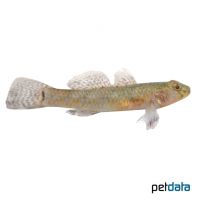White Cheek Goby (Rhinogobius duospilus)
| White Cheek Goby Rhinogobius duospilus | |
|---|---|
| Name | White Cheek Goby |
| Name Lat. | Rhinogobius duospilus |
| Synonym | Rhinogobius wui |
| Family | Gobies |
| Family lat. | Gobiidae |
| Order | Gobies |
| Order lat. | Gobiiformes |
| Origin | South Asia |
| Habitat | Mountain streams |
| Diet | Carnivore |
| pH | 6.5-7.5 |
| Behavior | Semi-aggressive |
| Keeping | Pair, group |
| Care Level | Moderate |
| Reproduction | Cave spawner |
| Breeding | Difficult |
| Life Span | 5-8 years |
| Protection | No |
| Metric Units | |
| Size | 4.5 cm |
| Temperature | 15-24 °C |
| Hardness | 5-15 °dH |
| Aquarium | 50 l |
| US Units | |
| Size | 1.8" |
| Temperature | 59-75 °F |
| Hardness | 89-267 ppm |
| Aquarium | 15 gal |
Distribution and habitat
The range of the white-cheeked goby extends from the southern Chinese mountains to Vietnam. They live in small, fast-flowing, oxygen-rich mountain streams with sandy-rocky bottoms among river pebbles, boulders, foliage and aquatic plants.
Maintenance
The aquarium should have partly dense planting and be structured with round river pebbles, flat stones and caves. A fine-grained substrate of round gravel, which can be covered with some foliage (sea almond tree, oak) and a moderate current is ideal
No ammonia, ammonium and nitrite should be detectable, the nitrate value should not exceed 100 mg/l. To ensure water quality and oxygen content, a filter and heater adapted to the aquarium size is required, as well as lighting for the species-appropriate day-night rhythm of the animals.
Diet
They feed mainly on insects, small crustaceans and plankton. The food supply consists of live or frozen cyclops, daphnia, bosmids, artemia, red mosquito larvae, etc. After acclimatization, high-quality, protein-rich dry food (granules, pellets, flakes) is also usually well accepted, but should not be the main component of the diet.
It is recommended to feed small portions several times a day. A regular and varied diet promotes health and increases resistance. Only as much should be fed as is eaten immediately (in a maximum of 10 minutes).
Behaviour and compatibility
White-cheeked gobies are occasionally somewhat rowdy and males engage in intraspecies bickering. They should be kept in pairs or in a small group where aggression is better distributed. Keeping a group is only recommended in a larger and richly structured tank. They can be well socialized with fish that reside in the upper water region
Basically, only compatible fish species with similar demands on water condition and water temperature should be socialized.
Sex dimorphism
The slightly paler males have a broader head, thicker lips and cheeks, and red spots and lines on the gill membranes (branchiostegal membranes). They threaten and impress by raising their heads and showing the distended gill membranes with the red spots.
Reproduction and breeding
They are cave breeders. The eggs are usually laid on the ceiling of a cave or crevice and guarded by the male. The larvae hatch after 3-4 days and float in the water. They begin to ingest minute food (rotifers) immediately after their yolk sac is depleted. After 9-12 days, their pelagic development is complete and the fry swim freely.
The fry must be fed several times a day with special rearing food (Artemia nauplii, microworms). In community tanks breeding is hardly possible, because the fry are easy prey.
Important
They like to sit on flat or round stones in the current. They originate from cool mountain streams and accordingly higher temperatures are not tolerated in the long run. Their body markings can vary greatly, except for the red dots on the underside of the head. The pale males can quickly change their color intensity, e.g. during territorial disputes
The well-being of the fish should be checked regularly. Temperature should be checked daily, pH, hardness and nitrate levels at least fortnightly. Regular partial water changes are recommended, even if the contaminant level has not yet reached the upper limit. Sudden changes in water quality should be avoided. Newly introduced fish must be accustomed slowly to the water in the aquarium.
Further literature can be found in your pet store.
References
Text: Werner Winter; Image: petdata
Source: BMELV (1998): Tierschutzgutachten - Haltung von Zierfischen (Süßwasser); BAENSCH & RIEHL (2004): Aquarien Atlas Bd. 2, Mergus Verlag; ENGELMANN (2005): Zootierhaltung - Tiere in menschlicher Obhut: Fische, Verlag Harri Deutsch
- Gemäß § 21 Abs. 5 Tierschutzgesetz idgF
